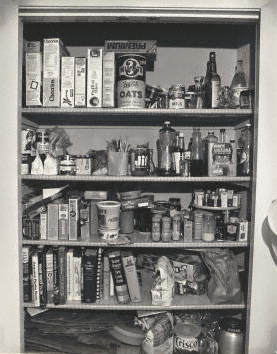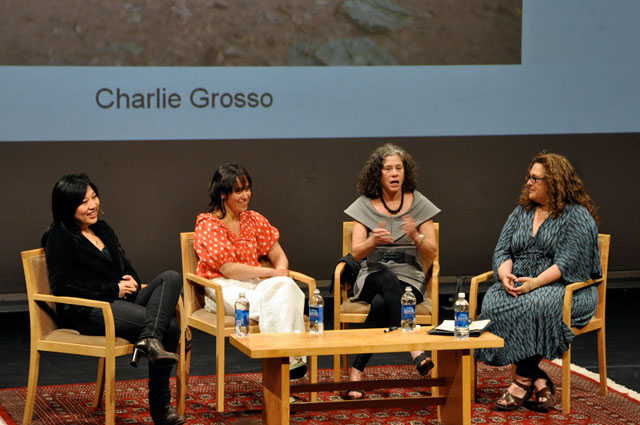
Untitled from the series British Food, Martin Parr, 1995. © Martin Parr/Magnum Photos
Drop your fork! I need to take a picture! Perhaps you’ve heard this exclamation, followed by the snap of a camera, while dining at a restaurant or sitting down to a home-cooked meal. Maybe you have even said it yourself, or spent time scrolling through photos of other people’s dinners on food blogs and Flickr groups like I Ate This. In this era of growing obsession with documenting and sharing our food online, what do our photographs say about us? And how might they compare to those displayed in an art museum?
On a recent evening at the Getty Center, art and food world luminaries—and a full-house audience—met to consider these questions alongside images from the Getty’s current exhibition In Focus: Tasteful Pictures, which features the delicious buttered bread featured above. If you thought photography, art, food, or social media were rich topics, imagine a conversation tackling all of these at once!
In preparation for the event, moderator Evan Kleiman of KCRW’s Good Food met with panelists Darra Goldstein, founding editor of Gastronomica, Maite Gomez-Rejón of Artbites, and photographer Charlie Grosso to view the works in the exhibition. Spanning the mid-19th century to today, the photographs offer a taste of everything from fruit staged in the studio to a hunting scene, groceries sold in the streets and supermarket, and even a carton of ice cream stuffed in a freezer.
Conversation was lively as the panelists walked through the gallery and encountered images both enticing and provocative. Kleiman, chef and owner of LA’s Angeli Caffe, was especially drawn to Paul Wolff’s Plate of Noodles with Fork, wondering aloud who had made those impressive-looking strands of pasta.

Untitled (Joy of Cooking), Bill Owens, 1971. © Bill Owens
Other works that captured their attention included Weegee’s Bagels, Second Avenue, an intriguing picture of a delivery man at once “jovial” and “menacing,” and Bill Owens’s Untitled (Joy of Cooking), a photograph of a pantry that instantly invites comparison to one’s own ingredients and cookbooks at home. Meanwhile, it was Taryn Simon’s thought-provoking “global still life” of foods confiscated at JFK International Airport that every panelist wanted for her own art collection.
And then it was time for the panelists to share their thoughts with a wider audience. Woven throughout their discussion was a comparison to our own culture of food photography shared on blogs, Flickr, and other digital forums. Just the day before, the New York Times had published an article entitled First Camera, Then Fork, which brought attention to the growing phenomenon of people documenting their meals. Kleiman referenced it throughout the talk, bridging the worlds of fine art and popular culture.

Charlie Grosso, Maite Gomez-Rejon, Darra Goldstein, and Evan Kleiman
How might a snapshot of tonight’s dinner relate to the works shown in In Focus: Tasteful Pictures? Do these two realms of food photography reveal similar or different types of information about their makers and cultural contexts? Goldstein said she considers images by photographers like those in the Getty exhibition to be “food photography,” while most blog images are “photographs of food.” In other words, the art images don’t focus on documentation so much as use food as a means to explore themes like culture, self, and body. Grosso concurred that images such as those in the exhibition “generate a larger conversation. They contain metaphor as opposed to, ‘This is what I ate today.’”
And yet, Grosso, herself a fine art photographer, considers food blogging a way for individuals to reach out and participate in a larger dialogue. “Food is cross-cultural, a point of connection amongst strangers,” she said. Goldstein agreed that this was true once the photograph was shared online, but said taking photographs can prevent a person from engaging more deeply with their food. Kleiman, who acknowledged that she loves Flickr, agreed that whipping out a camera before eating can be an impediment to enjoying the food. “We can’t just shut up and eat,” she said. “We have to memorialize and ponder.”
What do you think? When are images of food “just food,” and when are they something more? Does contemporary food blog photography continue the artistic tradition, or is it something else entirely?
The Picturing Food panel was organized by the J. Paul Getty Museum and Zócalo Public Square. For video and audio of the event, visit zocalopublicsquare.org.




Comments on this post are now closed.
Trackbacks/Pingbacks